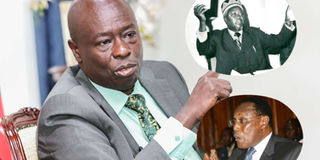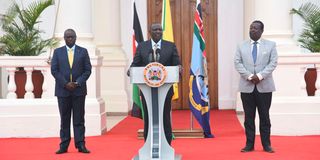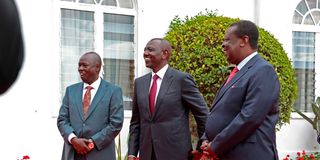Premium
Ghosts of VPs Jaramogi, Saitoti humiliation could come back to haunt DP Rigathi Gachagua

Deputy President Rigathi Gachagua. (Inset top) Kenya's first Vice President Jaramogi Oginga Odinga and George Saitoti (inset bottom).
What you need to know:
- Indications that Mudavadi’s ANCis ready to fold and join UDA have intensified jitters in DP Gachagua’s camp.
- When former President Moi entered a pact with Raila’s NDP, then Vice-President Saitoti was a major casualty.
- Kenya’s first Vice President Jaramogi Odinga Odinga suffered a similar fate in 1966 during the infamous Limuru Conference.
President William Ruto’s grand plan for some Kenya Kwanza affiliate parties to fold up and also the push to have a provision for three deputy party leaders in the UDA constitution appear to mirror political manoeuvres previously used to cut influential individuals down to size, settle scores, reward allies and create multiple centres of power.
When former President Daniel arap Moi of Kanu entered a pact with Raila Odinga’s National Development Party (NDP) in 2002, then Vice-President Professor George Saitoti was a major casualty.
He was dropped as the Kanu vice-chairperson and his slot taken over by four vice-chairmen. Both Moi and Saitoti are deceased.
Kenya’s first Vice President Jaramogi Odinga Odinga suffered a similar fate in 1966 during the infamous Limuru Conference, where his role as the deputy party leader was abolished and replaced by eight provincial vice-presidencies at the height of his fallout with the founding President Jomo Kenyatta. Jaramogi opted out of the race in protest.
Former President Mwai Kibaki also suffered the jinx of the deputy president’s seat being used to settle scores. During the 1988 Kanu elections, then President Moi replaced Vice-President Mr Kibaki with Josephat Njuguna Karanja. Mr Kibaki had opted out of the election.
There had been attempts to manipulate the 1988 vote for the Nyeri branch chairman’s position. Mr Kibaki told off the provincial administration. He is quoted as saying; “Even rigging required some intelligence”.
With the United Demoratic Alliance (UDA) scheduled to hold its grassroots elections starting from April 26, and which will culminate into a National Delegates Conference (NDC) to elect national officials, there is already sharp division within the ruling outfit. Allies of Deputy President Rigathi Gachagua are claiming that there is a plot to undermine him in the ruling party.
The UDA constitution provides for three deputy party leaders – one in charge of Policy and Strategy, another in charge of Operations while the third one is responsible for the party Programmes.

Deputy President Rigathi Gachagua (left), President Dr William Ruto and Prime Cabinet Secretary Musalia Mudavadi at State House in Nairobi on September 27, 2022.
Mr Gachagua’s allies want this provision amended to allow for a single deputy party leader.
Indications that the Amani National Congress (ANC), a party linked to Prime Cabinet Secretary Musalia Mudavadi, is ready to fold and join UDA have intensified jitters in Mr Gachagua’s camp.
There is a general feeling that should ANC join UDA, one of the deputy party leader slots would be taken up by Mr Mudavadi’s side, a scenario that will create another centre of power and expose Mr Gachagua in 2027 polls as well as in Dr Ruto’s succession.
Mr Mudavadi recently hinted at another political “earthquake”, akin to the one that altered the 2022 succession when he teamed up with Dr Ruto to the disadvantage of Mr Raila Odinga of the Azimio La Umoja coalition.
“I want to make it clear to other ANC supporters, although I may not be the official party leader today, but as a strong member, I must tell you frankly our conversation must be serious about how to strengthen the Kenya Kwanza administration and how to work closely with the UDA which is the principal party in the coalition and to even engage in deeper debates,” said Mr Mudavadi.
He added: “Don’t ask me which deeper debates. That is for another day. Another ‘earthquake’ is in the offing.”
David Monda, a Professor of Political Science at the City University of New York, says: “I see this as Ruto looking to check the Deputy President and keep the country guessing on his succession plans. Having Mudavadi as one of the UDA deputy leaders also allows the President to hedge his bets between two important electoral constituencies that he will need for reelection in 2027.”
He adds: “If it eventually happens, this is a hard power move by Ruto. It looks to undermine the influence of the DP position by creating multiple centres of power under the executive office of the President. Very much like what happened with the Kanu/NDP merger or the infamous 1966 Limuru Conference to check the power of the then VP, Jaramogi Odinga Odinga.”
Interviews with some of the UDA lawmakers on Friday exposed the infighting over the three positions.
UDA National Organising Secretary Vincent Musyoka Kawaya is among top party officials opposed to the creation of the three posts.
Mr Kawaya told Sunday Nation that the matter was yet to be discussed at the party level and it was causing anxiety among members.
“My personal position is that one deputy party leader is enough because if you have multiple people occupying the same position, they will fail to take responsibility,” said Mr Kawaya.
He said it would be a breach of protocol to have another member with the same responsibilities in the party as Mr Gachagua, who is the country’s Deputy President.

President William Ruto (centre), Deputy President Rigathi Gachagua (left) and Prime Cabinet Secretary Musali Mudavadi at State House, Nairobi on July 12, 2023.
“There is no sense in having three slots unless there is a motive to undermine the DP within the party. There must be protocol. We cannot allow a scenario where another member of the party will occupy the same position in the party as the DP. We can have multiple office holders in other positions but not for the party leader and deputy,” said the Mwala MP.
Similar views were shared by Nyaribari Chache MP Zaheer Jhanda, who said that they recognise only Mr Gachagua as the sole deputy party leader.
Also Read: Walking the talk - The Natembeya politics, Western kingpin debate and Wetang’ula, Mudavadi play
When UDA first postponed its polls last December, some politicians from Mt Kenya had demanded that the party constitution be amended to have one slot for deputy party leader.
“There must be a party leader and a deputy party leader. The rest can be whatever they want to be. We are demanding that as members,” Nyeri Governor Mutahi Kahiga said.
Mathira MP Eric Mwangi also made similar remarks: “We only have one President who is the party leader and one Deputy President who should be the only deputy party leader.”
But some UDA MPs, including Didmus Barasa (Kimilili), Nelson Koech (Belgut) and David Sankok (EALA) supported the creation of the three slots. The leaders argued that the positions are meant to give UDA a national outlook.
“Indeed, Article 24 of the UDA constitution anticipates there shall be three deputy party leaders, three deputy chairpersons, three deputy secretaries-general, three deputy treasurers and three national organising secretaries,” said Mr Koech.
“There is no need to overemphasise the triune nature of the deputy leader’s position when it is cross-cutting phenomenon and, when as things stand, the position is only occupied by one office holder despite the constitution providing otherwise.”
Mr Barasa dismissed claims that there was a plot to undermine Mr Gachagua. He said having three deputy party leaders will not take away the influence of Mr Gachagua as DP.
“It cannot undermine anybody. Having that provision in the party constitution was conversed by members of various party organs. There should be nothing to worry about,” said Mr Barasa.
Mr Sankok said having three deputy party leaders will ensure regional representation.
But analysts argue that some of the happenings mirror what befell Mr Odinga, Prof Saitoti and Mr Kibaki.
Following the 1997 General Election, Kanu and NDP entered into a “co-operation” that later became a merger on March 18, 2002.
Prof Saitoti having served as Moi’s Vic- President believed he had an upper hand in the 2002 succession. He was, however, surprised after he found out that his name had been removed from the list of vice-chairmen.
In his book Riding on a Tiger, former Vice- President Moody Awori writes about how Prof Saitoti was humiliated at Kasarani.
“He (Moi) then announced a merger between Kanu and NDP, and the NDP flag was lowered amidst cheers from the 6,000 delegates. He further announced that it had been decided that in the new Kanu, the position of national vice-chairman had been abolished and four vice-chairmen’s positions created,” says Mr Awori in his book.
“Joseph Kamotho, the Kanu super-hawk and apologist, was treated so despicably that he did not even defend his seat. He called it ‘kichinjio’ or slaughter house. As a result, Raila was elected unopposed (as Kanu Secretary- General). The President was also elected Kanu national chairman, unopposed,” he adds.
His election was proposed by Raila and seconded by Uhuru Kenyatta. Others elected unanimously included vice-chairmen Kalonzo Musyoka, Noah Katana Ngala, Musalia Mudavadi and Uhuru Kenyatta,” he narrates.
According to Mr Awori, President Moi reminded Prof Saitoiti that Kanu had “its owners.”
This resulted in Prof Saitoti making his famous: “There comes (sic) a time when the nation is more important than an individual.”
The former Vice-President then bowed out of the race.
The Kanu/NDP merger was to steer national politics but the marriage came to a tragic end when Moi named Mr Uhuru Kenyatta rather than Mr Odinga as his successor.





